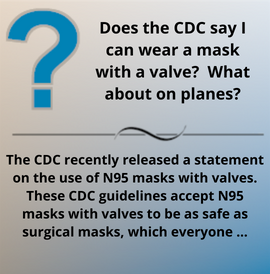 What does the CDC say about masks with valves?
What does the CDC say about masks with valves?
The CDC recently released a statement on the use of N95 masks with valves. These CDC guidelines accept N95 masks with valves to be as safe as surgical masks, which everyone accepts as protective. While the CDC has changed its position on masks with valves, it may take time for the airlines and governments to catch up with current CDC guidelines, and therefore you should be prepared for push back if you wear a mask with a valve.
This is the statement on the CDC website:
"Yes, an N95 filtering facepiece respirator will protect you and provide source control to protect others. A NIOSH-approved N95 filtering facepiece respirator with an exhalation valve offers the same protection to the wearer as one that does not have a valve. As source control, findings from NIOSH research suggest that, even without covering the valve, N95 respirators with exhalation valves provide the same or better source control than surgical masks, procedure masks, cloth masks, or fabric coverings. In general, people wearing NIOSH-approved N95s with an exhalation valve should not be asked to use one without an exhalation valve or to cover it with a face covering or mask. However, an N95 filtering facepiece respirator with a valve may not provide the same level of source control as an N95 without a valve. To make an N95 have similar source control to one without a valve, follow the manufacturer’s instructions to cover the valve.
Note that NIOSH-approved N95 respirators with an exhalation valve are not fluid resistant. Therefore, in situations where a fluid resistant respirator is indicated (e.g., in surgical settings), people should wear a surgical N95 or, if a surgical N95 is not available, cover their respirator with a surgical mask or a face shield. Be careful not to compromise the fit of the respirator when placing a facemask over the respirator."
|
Related Links: CDC Statement about masks with valves
|

